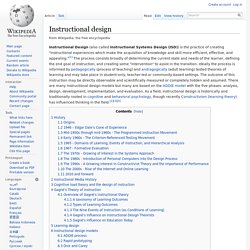

Instructional Design - Learning futures. Instructional Design: Resources - Learning futures. Why Online Courses [Really] Need an Instructional Design Strategy. In this post I examine and define instructional design, and share why it’s essential to the development of online courses.
![Why Online Courses [Really] Need an Instructional Design Strategy](http://cdn.pearltrees.com/s/pic/th/courses-instructional-strategy-107003880)
“Design brings forth what would not come naturally“ Klaus Krippendorff Developing an online course that is engaging, promotes interaction, motivates learners, and above all facilitates learning is easier said than done. It’s even more challenging when trying to modify a face-to-face course for the online format. I know because I worked at a four-year college as lead curriculum designer where my job was to collaborate with faculty to transition their face-to-face courses to a 100% online course.
During the process of converting more than fifteen courses I became even more appreciative of the principles and process of instructional design. The Design Process for Online Courses, by Giulia Forsythe (Flickr) I have over twelve years experience as an instructional designer, which includes creating management development courses and employee training programs. I. II. III. Instructional Design Models and Methods. Instructional Design Models and Methods "Models, like myths and metaphors, help us to make sense of our world.

Whether derived from whim or from serious research, a model offers its user a means of comprehending an otherwise incomprehensible problem. An instructional design model gives structure and meaning to an I.D. problem, enabling the would-be designer to negotiate her design task with a semblance of conscious understanding. Models help us to visualize the problem, to break it down into discrete, manageable units.
The value of a specific model is determined within the context of use. Open Educational Resources Meet Instructional Design. Well, we made it to 2015, the year in which we were supposed to have hover boards, flying cars, and the Cubs winning the World Series (that may still happen).

Back to the Future II gave us a glimpse of what 2015 might look like through the eyes of Doc Brown and Marty McFly. Despite the many great innovations we've developed since that 1989 movie, one constant remains in our world: paper. Despite advances in tablet technology and eReaders, paper has found a way to coexist with technology and live on. Personally, I enjoy reading a book made out of paper. I also like the romanticism of the Sunday New York Times and a cup of coffee. Asking the Right Questions In my previous post, I suggested a strategy that would help organize the transition from textbooks to digital content delivery. What skills do you want students to learn and apply? Ultimately, these questions will help begin the instructional design process. Finding the Right Content iTunesU OER Commons.
Introduction to Instructional Systems Design. Course Description Instructional Systems Design is the process of designing and developing instructional courses or materials that bring greater efficiency and effectiveness to acquiring knowledge or skills for learners.

This free online course in Instructional Systems Design reviews important aspects such as learning theories and learning objectives and how they influence the design process. It also reviews the role of memory, needs analysis, and design models such as ADDIE (Analysis, Design, Development, Implementation, and Evaluation). Robert Gagne's Nine Events of Instruction are also discussed with examples of their application and use.
Finally, learning technologies and how they are used to deliver training are reviewed, as well as techniques for measuring and evaluating the effectiveness of the instructional materials. Certification Learning Outcomes. Instructional Design Articles. Instructional Design Central. Instructional Design. Instructional design. History[edit] Origins[edit] During World War II, a considerable amount of training materials for the military were developed based on the principles of instruction, learning, and human behavior.

Tests for assessing a learner’s abilities were used to screen candidates for the training programs. After the success of military training, psychologists began to view training as a system, and developed various analysis, design, and evaluation procedures.[5] 1946 – Edgar Dale’s Cone of Experience[edit] In 1946, Dale outlined a hierarchy of instructional methods and their effectiveness.[6] Mid-1950s through mid-1960s - The Programmed Instruction Movement[edit] Early 1960s - The Criterion-Referenced Testing Movement[edit] Robert Glaser first used the term “criterion-referenced measures” in 1962.